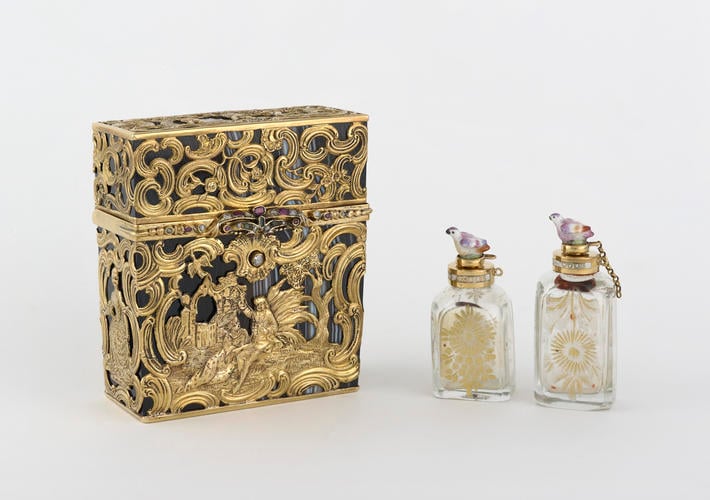-
1 of 253523 objects
England
Scent bottle holder c. 1750
Agate, gold, glass, diamonds, emeralds, rubies | 7.4 x 7.1 x 3.6 cm (whole object) | RCIN 4544
-
Rectangular box of agate mounted with gold cagework containing two scent bottles. Plain rim mounted at front with dragonfly set with rubies, diamonds and emeralds above a diamond press thumbpiece. The cagework is chased in relief with flowers, c-scrolls and figures.
This object is an item which was typically purchased in an English toyshop of the period. A bill to Frederick, Prince of Wales, from the shop of Paul Bertrand of October 1738 included not only eight snuff boxes in various materials, but also two etuis, two pocket books, a toothpick case, a gold ‘smelling bottle’ and an onyx egg. The Prince paid £21 for a single etui, and a protective outer case for one of these items cost as much as ten guineas. An etui was a small case to contain implements for writing, manicure or sewing, and so-named after the French word estuier meaning to keep. The bill from Bertrand shows that the items contained within an etui were sold separately – the Prince paid £5 15s 6d for ‘trincketts’ for his bloodstone example, together with a set of five chains to suspend it from a belt.
Mary Delany’s letter to her sister Anne Dewes, of 14-17 January 1756 suggests that these small objects were an essential element of one’s fashionable costume. Describing the clothes of their cousin Mrs Spencer on her first visit to Court, she notes not only her white and silver dress and her lavish diamond jewellery but also ‘her watch and etuy suited to the rest’.
Bertrand’s bill makes clear that these luxury scent bottle cases and etuis came in a range of materials and decorative finishes – Frederick bought not only ‘an inlay’d estwey’ but also versions in bloodstone and carnelian. The use of polished hardstones was also described by Mrs Delany, who, on 22 April 1740, visited ‘Faulkner’s the famous lapidary, where we saw abundance of fine things, and the manner of cutting and polishing pebbles &c’.
Text adapted from The First Georgians: Art and Monarchy 1714 - 1760, London, 2014Provenance
Acquired by Queen Mary
-
Creator(s)
(nationality)Acquirer(s)
-
Medium and techniques
Agate, gold, glass, diamonds, emeralds, rubies
Measurements
7.4 x 7.1 x 3.6 cm (whole object)

